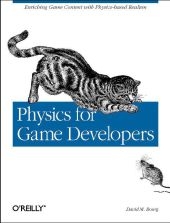
Physics for Games Developers
O'Reilly Media (Verlag)
978-0-596-00006-6 (ISBN)
- Titel ist leider vergriffen;
keine Neuauflage - Artikel merken
Colliding billiard balls. Missile trajectories. Cornering dynamics in speeding cars. By applying the laws of physics, you can realistically model nearly everything in games that bounces around, flies, rolls, slides, or isn't sitting still, to create compelling, believable content for computer games, simulations, and animation. Physics for Game Developers serves as the starting point for those who want to enrich games with physics-based realism. Part one is a mechanics primer that reviews basic concepts and addresses aspects of rigid body dynamics, including kinematics, force, and kinetics. Part two applies these concepts to specific real-world problems, such as projectiles, boats, airplanes, and cars. Part three introduces real-time simulations and shows how they apply to computer games.
Many specific game elements stand to benefit from the use of real physics, including: *The trajectory of rockets and missiles, including the effects of fuel burn off *The collision of objects such as billiard balls *The stability of cars racing around tight curves *The dynamics of boats and other waterborne vehicles *The flight path of a baseball after being struck by a bat *The flight characteristics of airplanes You don't need to be a physics expert to learn from Physics for Game Developers, but the author does assume you know basic college-level classical physics. You should also be proficient in trigonometry, vector and matrix math (reference formulas and identities are included in the appendixes), and college-level calculus, including integration and differentiation of explicit functions. Although the thrust of the book involves physics principles and algorithms, it should be noted that the examples are written in standard C and use Windows API functions.
As a naval architect and marine engineer, David M. Bourg performs computer simulations and develops analysis tools that measure such things as hovercraft performance and the effect of waves on the motion of ships and boats. He teaches at the college level in the areas of ship design, construction and analysis. On occasion, David also lectures at high schools on topics such as naval architecture and software development. In addition to David's practical engineering background, he's professionally involved in computer game development and consulting through his company, Crescent Vision Interactive. Current projects include a massively multiplayer online role-playing game, several Java-based multiplayer games, and the porting of Hasbro's "Breakout" to the Macintosh.
Table of Contents Preface 1. Basic Concepts Newton's Laws of Motion Units and Measures Coordinate System Vectors Mass,Center of Mass,and Moment of Inertia Newton's Second Law of Motion Inertia Tensor 2. Kinematics Introduction Velocity and Acceleration Constant Acceleration Nonconstant Acceleration 2D Particle Kinematics 3D Particle Kinematics Kinematic Particle Explosion Rigid Body Kinematics Local Coordinate Axes Angular Velocity and Acceleration 3. Force Introduction Force Fields Friction Fluid Dynamic Drag A Note on Pressure Buoyancy Springs and Dampers Force and Torque 4. Kinetics Particle Kinetics in 2D Particle Kinetics in 3D Rigid Body Kinetics 5. Collisions Impulse-Momentum Principle Impact Linear and Angular Impulse Friction 6. Projectiles Simple Trajectories Drag Magnus Effect Variable Mass 7. Aircraft Geometry Lift and Drag Other Forces Control Modeling 8. Ships Flotation Volume Resistance Virtual Mass 9. Hovercraft How They Work Resistance 10. Cars Resistance Power Stopping Distance Roadway Banking 11. Real-Time Simulations Integrating the Equations of Motion Euler's Method Other Methods 12. 2D Rigid Body Simulator Model Integration Flight Controls Rendering 13. Implementing Collision Response Linear Collision Response Angular Effects 14. Rigid Body Rotation Rotation Matrices Quaternions 15. 3D Rigid Body Simulator Model Integration Flight Controls Rendering 16. Multiple Bodies in 3D Model Integration Collision Response Tuning 17. Particle Systems Model Integration Collision Response Tuning Appendix A: Vector Operations Appendix B: Matrix Operations Appendix C: Quaternion Operations Bibliography Index
| Erscheint lt. Verlag | 18.12.2001 |
|---|---|
| Zusatzinfo | 1, black & white illustrations |
| Verlagsort | Sebastopol |
| Sprache | englisch |
| Maße | 178 x 233 mm |
| Gewicht | 550 g |
| Einbandart | kartoniert |
| Themenwelt | Mathematik / Informatik ► Informatik ► Programmiersprachen / -werkzeuge |
| Informatik ► Weitere Themen ► Computerspiele | |
| Naturwissenschaften ► Physik / Astronomie | |
| ISBN-10 | 0-596-00006-5 / 0596000065 |
| ISBN-13 | 978-0-596-00006-6 / 9780596000066 |
| Zustand | Neuware |
| Haben Sie eine Frage zum Produkt? |
aus dem Bereich



